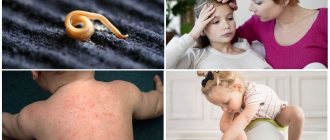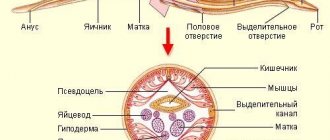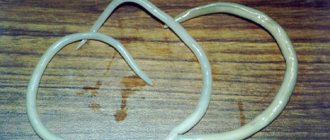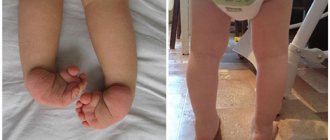Causes of pinworms in children
The spread of these parasites occurs through eggs, which can be transmitted through contact and household contact. This is a very common route of infection, because in kindergartens and schools children very often exchange toys, writing materials and use the same toilet. After entering the body, pinworms begin to multiply quickly and cause enterobiasis in children. This disease is very difficult to treat, so it is much wiser to avoid it than to deal with its consequences.
Pinworms in children can appear due to direct contact with a sick baby. It is known that parasites cause itching in the anal area; children, scratching their butts, put eggs under their nails, then in contact with another baby, they transmit them. Eggs can also be transmitted through soft toys played with by an infected baby, through household appliances and hygiene items.
It should be noted that flies can become carriers of pinworms if a person eats food on which the carrier fly was sitting; the parasite enters the body orally. In small quantities, pinworm eggs can be found in animal fur, and we are talking not only about stray dogs and cats, but also pets. There are a huge number of parasites, the primary host of which is cats. This is why it is so important for children to wash their hands after playing with pets.
Pinworms in both children and adults have one characteristic feature: at night they crawl out to the external anus to lay eggs there. In one foray, a female pinworm can lay up to 15 thousand eggs. Further, the migration pattern of pinworms in children is simple and understandable. With laundry, it can get to the mother, who subsequently washes it, on the hands of children, who spread the eggs through contact, and on household appliances.
Many mothers wonder why pinworms appear in children under one year of age, and it will be unpleasant for them to hear the answer, because the main source at this age is the adults themselves. Parasites cannot settle in the body of a newborn through contact with animals or due to dirty hands; they are introduced by mothers who wash their babies’ perineals, feed them, and touch their toys. During the period of teeth appearing, children put various things into their mouths that infected adults could come into contact with, and the main thing for the parasite is to get on the mucous membrane, then it will find a “shelter”.
Methods of infection
The reasons for helminth eggs entering a child’s body are different. This could be a household infection, that is, failure to comply with basic hygiene rules. These include not only thorough hand washing after a walk, before eating, after going to the toilet, but also washing all vegetables and fruits before eating.
Children who have already been infected re-infect themselves orally. At night, females crawl out through the anus and lay eggs. They cause itching, the child scratches the itchy area, and again infects himself by simply raising his hand to his mouth, as pinworm eggs stick to the fingers and accumulate under the nails. With the same hands, children spread eggs throughout the house, touching clothes and toys.
Infection occurs through contact from egg carriers already infected with parasites. Despite the fact that the species of pinworms that infect humans do not parasitize the bodies of cats and dogs, they can still carry eggs on their fur if these eggs are already in the apartment, on children’s toys, furniture, etc.
Important! Until a child learns to follow the rules of hygiene, he is always at risk of becoming infected with pinworms. Try to teach your baby to cleanliness as quickly as possible.
Symptoms of enterobiasis in children
Herb Troychatka Evolar: reviews of parasitologists about the medicine
Enterobiasis in children has very pronounced symptoms, it is simply impossible not to notice them. Pinworms in children have the same symptoms and treatment as in adults, the difference is that children describe the presence of the parasite in the body differently. If an adult describes the presence of a foreign object in the anus, the baby will say that something is pricking and bothering him. Sick children constantly try to scratch their butts; if enterobiasis in children remains untreated for a long time, the itching will only intensify. After some time, adults may notice that their child itches less and mistakenly assume that the parasites have died, but this is not the case. Enterobiasis in infants and school-age children cannot go away on its own.
If you notice a decrease in the intensity of itching in your baby, this indicates a change of generation. The life cycle of pinworms is not long and lasts only a few weeks, after which they die. In this case, the colony is reborn, but is not replenished; new individuals will appear from the eggs, which will then also die, but will leave eggs behind.
Signs of enterobiasis in children can be supplemented by small cracks and erosions around the anus. The fact is that a child, scratching the area near the anus, injures the skin and scratches it. If a bacterial infection gets into the crack, swelling, inflammation and painful wounds will appear, which will further aggravate the treatment process.
Pinworms in children can cause defecation disorders - constipation and diarrhea. It is very important to know what pinworms look like, because sometimes adult pinworms are found in feces. Outwardly, they resemble a white stick, something like a grain of rice. If a child has pinworms, his stool will have a mushy, shapeless consistency, mixed with mucus and blood.
In medical practice, there is a theory that the presence of pinworms in children can provoke appendicitis. It is for this reason that symptoms are often supplemented by abdominal pain, lack of appetite, attacks of nausea, dizziness, vomiting and fever. It should also be noted that pinworms themselves are very mobile parasites and can easily crawl from the anus to the genitals of children. Girls can develop vulvovaginitis, endometritis and a number of other inflammatory diseases, and in boys, as a rule, the head of the genital organ becomes inflamed and pain occurs when urinating.
Treatment of enterobiasis in children
Your doctor can tell you how to treat pinworms on an individual basis. After a series of diagnostic procedures, the doctor, based on the individual characteristics of the patient, selects appropriate medications. In most cases, they are different from adult medications. Children's drugs have less toxicity, and the number of side effects after them is reduced to a minimum. If enterobiasis is observed in children, symptoms and treatment are carried out with drugs such as:
- Levamisole;
- Pyrantel;
- Mebendazole;
- Vermox;
- Telmox;
- Medamin;
- Nemozol.
Treatment for pinworms in children is a long and troublesome process; most mothers, after the first unsuccessful attempt to cure enterobiasis, complain about the ineffectiveness of the above drugs. The thing is that a colony of parasites can be huge, and it is impossible to eliminate them all at once. In addition, in order to obtain a positive therapeutic effect from antiparasitic drugs, it is necessary to stop giving the patient foods that strengthen the stool. The evening before the first dose of the medicine, you need to give him a laxative. The above medications kill only adults and do not hatch eggs. Accordingly, over time, the colony is revived, and the infection will recur. To remove eggs, it is worth giving the child enemas and giving him a laxative throughout the treatment.
Drugs for the treatment of tapeworms in humans
To completely eliminate pinworms in children under one year of age and school age, it is necessary to repeat the course of drug therapy two weeks later. You should not ignore the signs of pinworms; if a child has itching and allergic reactions, it is important to give him antihistamines, for example, Cetrin or Loratodine.
Folk remedies
Treatment with folk remedies has never been welcomed by traditional medicine, but sometimes combination therapy gives results much faster. It is not wise to use a remedy for pinworms in children of plant origin as the main treatment, but it is possible, and even necessary, to supplement medications with it.
How to treat enterobiasis is described by a huge number of folk recipes; a herbal mixture of tansy, cloves, mint, burdock and chamomile has proven itself especially well. The herbs are mixed together and, poured with boiling water, given to the child as tea, three times a day.
Pumpkin seeds, sauerkraut juice, and cucumber pickle will help get rid of parasites. An acidic environment is poorly tolerated by parasites, and they rush to leave their unfavorable “place of residence.”
What parasites are is quite difficult to explain to a child, but what to do, leave everything as is, and watch the baby suffer? - In no case, there is one way that will certainly please capricious children who refuse to take medicine. Few people know, but coconut flakes and coconut milk have antiparasitic properties. You need to mix these two ingredients and leave it in the refrigerator for a day. Then give it to children a teaspoon before meals, three times a day.
Our great-grandmothers knew how to deal with pinworms in children; they used a simple decoction of onions and honey. All you need is to pour boiling water over the chopped onion pulp and add a spoonful of honey. After the broth has cooled a little, it is filtered and given to children twice a day.
If the above remedies do not produce results within two weeks or you notice additional symptoms in your child, immediately stop self-medication and consult a doctor.
Preparations for pinworms
The question of how to get rid of pinworms has been studied quite well. The pharmacological industry produces many drugs with which enterobiasis can be cured in a short time.
Popular ones include:
- Pyrantel;
- Albendazole;
- Mebendazole;
- Levamisole;
- Niclosamide.
Each of them should be considered in more detail.
Pirantel
This medicine for pinworms, which has a wide spectrum of action, disrupts the process of neuromuscular impulse transmission, which leads to paralysis of the helminth. Immobilized worms are released into the external environment with feces.
The drug is low-toxic, can be used to treat pediatric patients, and is available in the form of tablets and syrup.
Indications for use are:
- Hookworm disease;
- Necatoriasis;
- Enterobiasis;
- Ascariasis.
After taking the drug, short-term abdominal pain, nausea or vomiting may occur.
For the treatment of enterobiasis, pyrantel is taken once. The dose is calculated using the formula 10 mg × body weight in kilograms. Treatment is carried out not only for the patient himself, but also for all persons living with him. The medicine is contraindicated in case of hypersensitivity to its components. A relative contraindication is pregnancy.
Note: treatment with pyrantel during pregnancy is possible if the benefit to the mother outweighs the possible risk to the fetus.
Albendazole
The drug in therapeutic concentration is harmful to parasites. The action is based on disruption of the process of beta-tubulin polymerization and glucose utilization. The helminths become paralyzed and actually die from starvation.
Albendazole is used for:
- Enterobiasis;
- Ascariasis;
- Infection with tapeworms;
- Microsporidosis;
- Ankylostomiasis;
- Mixed invasions.
The drug is taken orally after eating. There is no need to take a laxative later.
For enterobiasis, albendazole should be taken at a dose of 400 mg for adults and 200 mg for children under 14 years of age. The medicine is taken once, but the dose is repeated after 3 weeks.
As a rule, no side effects are observed with a single dose. In rare cases, abdominal pain, meningeal symptoms, and dyspepsia may occur. The drug is contraindicated in children under 2 years of age, pregnant and lactating women.
Mebendazole
It has a principle of action similar to albendazole. Indicated for infestations of roundworms and tapeworms, it is an excellent remedy for combating pinworms.
For enterobiasis, mebendazole is used once. After two weeks, the dose is repeated. The adult dose is 100 mg. Children from 2 to 14 years old are given 25-50 mg of medication per dose. For ease of use, tablets can be crushed and added to food. No special diet is required during treatment.
During treatment, dyspepsia, headache, nausea, and dizziness may develop. With a single dose of medication, side effects are rare. Mebendazole is contraindicated in children under 2 years of age and pregnant women. The drug reduces the need for insulin, which should be taken into account when treating patients with diabetes.
Levamisole
A dual-action drug with anthelmintic and immunomodulator properties. Paralyzes helminths, after which they are eliminated from the body by natural peristalsis within 24 hours.
As a medicine against parasites, levamisole is prescribed for infestations such as:
- Toxoplasmosis;
- Necatoriasis;
- Hookworm disease;
- Ascariasis;
- Strongyloidiasis;
- Tricurosis;
- Enterobiasis;
- Trichostrongyloidosis.
For the treatment of pinworms, the medicine is prescribed at 150 mg for adults and 2.5 mg/kg for children. The dose is taken once, in the evening.
After using levamisole, nausea, diarrhea, headache, and weakness are possible. Contraindicated in case of renal and liver failure, blood diseases. There is no reliable data on the effect of the drug on the fetus.
Note: concomitant use of levamisole with alcohol causes a disulfiram-like reaction.
Niclosamide
One of the strongest anthelmintic drugs. It is used mainly to combat tapeworms (bovine and pork tapeworms), as well as in the treatment of echinococcosis. It is rarely used to remove pinworms, since its effect on this type of parasite is weak.
For enterobiasis, niclosamide is taken once, in the following doses:
- Children over 12 years old and adults - 2 grams;
- Children 5-11 years old - 1.5 grams;
- Children 2-4 years old - 1 gram;
- Children under 2 years old - 0.5 grams.
Treatment is carried out on an empty stomach or in the evening, 2 hours after a light dinner. After taking, nausea and allergic reactions are possible. The drug is contraindicated for stomach ulcers, anemia, renal and liver failure, and for pregnant and lactating women.
Prevention of pinworms in children
Prevention of pinworms in children is the wisest decision of an adult; it is much wiser to prevent the development of the parasite in the baby’s body than to deal with the consequences of its life activity. You can prevent the parasite from entering your body by following the rules of personal hygiene. Adults are obliged to constantly monitor the cleanliness of the baby’s hands and teach him to wash his hands after using the toilet or visiting crowded places. Always try to trim your child’s nails and change and wash his underwear in a timely manner. An excellent way to prevent parasites from entering the body is to iron washed underwear and bedding. All parasites, and pinworms in particular, cannot tolerate high temperatures.
Do not forget to wet clean and disinfect the bathroom and toilet. If you, while using medications and carefully following the doctor’s recommendations, do not adhere to the above recommendations, your treatment will be reduced to zero. No matter how strong the drug is, if infection occurs repeatedly, there will be no effect, but the liver and other organs will suffer from its toxic effect.
What is enterobiasis, now you know. You can think as much as you like about the reasons for the appearance of pinworms in your baby, but only on the way to a qualified specialist. It is unacceptable to self-medicate a growing organism for a long time. The longer the parasite remains in orgasm, the more difficult it will be to remove it later, and the more toxic poisoning the baby will receive.












